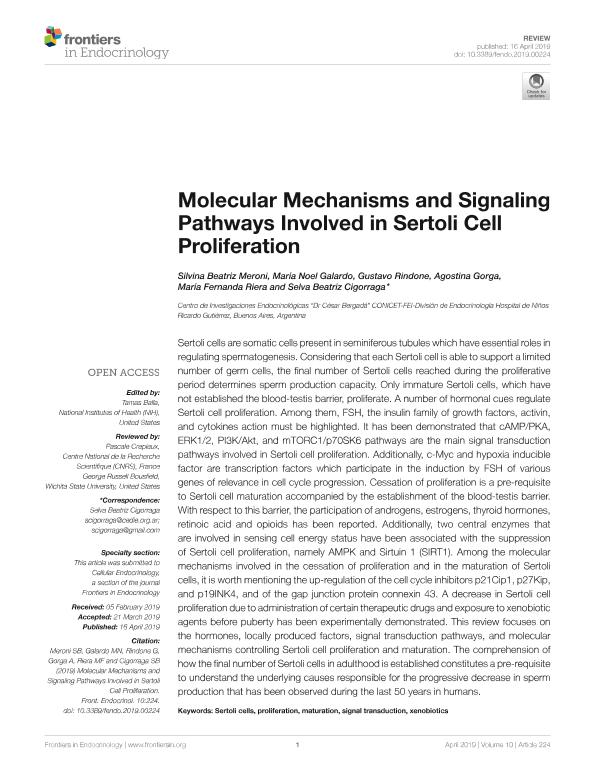Artículo
Molecular mechanisms and signaling pathways involved in Sertoli cell proliferation
Meroni, Silvina Beatriz ; Galardo, Maria Noel Lujan
; Galardo, Maria Noel Lujan ; Rindone, Gustavo Marcelo
; Rindone, Gustavo Marcelo ; Gorga, Agostina
; Gorga, Agostina ; Riera, Maria Fernanda
; Riera, Maria Fernanda ; Cigorraga, Selva Beatriz
; Cigorraga, Selva Beatriz
 ; Galardo, Maria Noel Lujan
; Galardo, Maria Noel Lujan ; Rindone, Gustavo Marcelo
; Rindone, Gustavo Marcelo ; Gorga, Agostina
; Gorga, Agostina ; Riera, Maria Fernanda
; Riera, Maria Fernanda ; Cigorraga, Selva Beatriz
; Cigorraga, Selva Beatriz
Fecha de publicación:
04/2019
Editorial:
Frontiers Media
Revista:
Frontiers in Endocrinology
ISSN:
1664-2392
Idioma:
Inglés
Tipo de recurso:
Artículo publicado
Clasificación temática:
Resumen
Sertoli cells are somatic cells present in seminiferous tubules which have essential roles in regulating spermatogenesis. Considering that each Sertoli cell is able to support a limited number of germ cells, the final number of Sertoli cells reached during the proliferative period determines sperm production capacity. Only immature Sertoli cells, which have not established the blood-testis barrier, proliferate. A number of hormonal cues regulate Sertoli cell proliferation. Among them, FSH, the insulin family of growth factors, activin, and cytokines action must be highlighted. It has been demonstrated that cAMP/PKA, ERK1/2, PI3K/Akt, and mTORC1/p70SK6 pathways are the main signal transduction pathways involved in Sertoli cell proliferation. Additionally, c-Myc and hypoxia inducible factor are transcription factors which participate in the induction by FSH of various genes of relevance in cell cycle progression. Cessation of proliferation is a prerequisite to Sertoli cell maturation accompanied by the establishment of the blood-testis barrier. With respect to this barrier, the participation of androgens, estrogens, thyroid hormones, retinoic acid and opioids has been reported. Additionally, two central enzymes that are involved in sensing cell energy status have been associated with the suppression of Sertoli cell proliferation, namely AMPK and Sirtuin 1 (SIRT1). Among the molecular mechanisms involved in the cessation of proliferation and in the maturation of Sertoli cells, it is worth mentioning the upregulation of the cell cycle inhibitors p21Cip1, p27Kip, and p19INK4, and of the gap junction protein connexin 43. A decrease in Sertoli cell proliferation due to administration of certain therapeutic drugs and exposure to xenobiotic agents before puberty has been experimentally demonstrated. This review focuses on the hormones, locally produced factors, signal transduction pathways, and molecular mechanisms controlling Sertoli cell proliferation and maturation. The comprehension of how the final number of Sertoli cells in adulthood is established constitutes a pre-requisite to understand the underlying causes responsible for the progressive decrease in sperm production that has been observed during the last 50 years in humans.
Palabras clave:
MATURATION
,
PROLIFERATION
,
SERTOLI CELLS
,
SIGNAL TRANSDUCTION
,
XENOBIOTICS
Archivos asociados
Licencia
Identificadores
Colecciones
Articulos(CEDIE)
Articulos de CENTRO DE INVESTIGACIONES ENDOCRINOLOGICAS "DR. CESAR BERGADA"
Articulos de CENTRO DE INVESTIGACIONES ENDOCRINOLOGICAS "DR. CESAR BERGADA"
Citación
Meroni, Silvina Beatriz; Galardo, Maria Noel Lujan; Rindone, Gustavo Marcelo; Gorga, Agostina; Riera, Maria Fernanda; et al.; Molecular mechanisms and signaling pathways involved in Sertoli cell proliferation; Frontiers Media; Frontiers in Endocrinology; 10; MAR; 4-2019; 1-22
Compartir
Altmétricas



